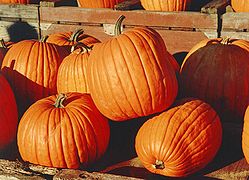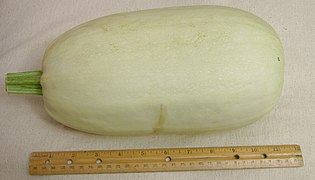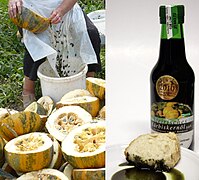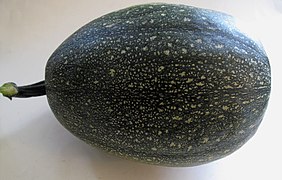Cucurbita pepo
| Cucurbita pepo | |
|---|---|

| |
| Assorted cultivars, from top-left, clockwise: pattypan squash, yellow summer squash, a large zucchini (or marrow), and pumpkins | |
| Scientific classification | |
| Kingdom: | Plantae |
| Clade: | Tracheophytes |
| Clade: | Angiosperms |
| Clade: | Eudicots |
| Clade: | Rosids |
| Order: | Cucurbitales |
| Family: | Cucurbitaceae |
| Genus: | Cucurbita |
| Species: | C. pepo
|
| Binomial name | |
| Cucurbita pepo | |
| Synonyms[2] | |
| |
Cucurbita pepo is a cultivated plant of the genus Cucurbita. It yields varieties of winter squash and pumpkin, but the most widespread varieties belong to the subspecies Cucurbita pepo subsp. pepo, called summer squash.[3]
It has been domesticated in the Americas for thousands of years.[4] Some authors maintain that C. pepo is derived from C. texana, while others suggest that C. texana is merely feral C. pepo.[5] They have a wide variety of uses, especially as a food source and for medical conditions. C. pepo seems more closely related to C. fraterna, though disagreements exist about the exact nature of that connection, too.[6]
It is a host species for the melonworm moth, the squash vine borer, and the pickleworm. They are also the preferred pollen for squash bees.
Description
[edit]Due to their varied genetic background, members of C. pepo vary widely in appearance, primarily in regards to their fruits. The plants are typically .30–.76 metres (1–2+1⁄2 ft) high and 0.61–0.91 m (2–3 ft) wide, with yellow flowers.[7] Within C. pepo, the pumpkins, scallops, and possibly crooknecks are ancient and were domesticated separately. The domesticated species have larger fruits and larger yet fewer seeds.[8] Parthenocarpy is known to occur in certain cultivars of C. pepo.[9][10]
The leaves have three to five lobes and are 20–35 centimetres (8–14 in) wide. All the subspecies, varieties, and cultivars are conspecific and interfertile.
Taxonomy
[edit]Origin and history
[edit]C. pepo is one of the oldest, if not the oldest domesticated species.[5][11][12] The oldest known locations are in southern Mexico in Oaxaca 8,000–10,000 years ago and Ocampo, Tamaulipas, Mexico about 7,000 years ago.[5][11][12]
Before the arrival of Europeans, C. pepo, along with C. moschata, had been carried over all parts of North America where they could be grown.[13] The ancient territory of C. pepo extended north into Texas and up the Greater Mississippi River Valley into Illinois and east to Florida, and possibly even to Maine.[6] It is one of several plants cultivated in prehistoric North America as part of the Eastern Agricultural Complex. It is known to have appeared in Missouri at least 4,000 years ago.[14] Some varieties grow in arid regions and some in moist regions.[6] Many of these peoples, particularly in the west, still grow a diversity of hardy squashes and pumpkins not to be found in commercial markets.[13] Still, neither C. pepo nor C. moschata had been carried into South America as had beans, which originated in the same general region.[13]
Debates about the origin of C. pepo have been going on since at least 1857.[15] Recent biosystematic investigations indicate two distinct domestication events in two different areas: one in Mexico and one in the eastern United States, with C. pepo subsp. fraterna and C. pepo subsp. texana, respectively, as the predominant ancestral species from a phylogenetic perspective.[14][16][17][18]
Subdivision
[edit]The morphological differences within the species C. pepo are so vast that its various subspecies and cultivars have been misidentified as totally separate species. These vast differences are rooted in its widespread geographic distribution.[6]
Several taxa have been proposed, but as of 2012 none has been universally accepted.[19] In 2002, the taxa conventions proposed by Decker-Walters were:[6]
- C. pepo subsp. pepo - cultivated pumpkins, marrows, the orange gourds ("Orange Ball" and "Orange Warted")
- C. pepo subsp. ovifera var. ovifera – cultivated crooknecks, scallops, acorns, most ornamental gourds
- C. pepo subsp. ovifera var. ozarkana – wild populations in the Greater Mississippi Valley and Ozark Plateau
- C. pepo subsp. ovifera var. texana – wild populations in Texas
- C. pepo subsp. fraterna – wild populations in northeastern Mexico
A 2003 study recognized three subspecies:[20]
- Cucurbita pepo subsp. fraterna
- Cucurbita pepo subsp. pepo
- Cucurbita pepo subsp. texana
In 1986, botanist Paris proposed a taxonomy of C. pepo consisting of eight edible groups based on their basic shape.[8][21] All but a few C. pepo cultivars can be included in these groups.[21] These eight edible cultivated varieties of C. pepo vary widely in shape and color,[14][22][23] and one inedible cultivated variety:[24]
| Cultivar group | Botanical name | Image | Description |
|---|---|---|---|
| Acorn | C. pepo var. turbinata |  |
winter squash, both a shrubby and creeping plant, obovoid or conical shape, pointed at the apex and with longitudinal grooves, thus resembling a spinning top,[21] ex: Acorn squash[14][22][23] |
| Cocozelle | C. pepo var. longa |  |
summer squash, long round slender fruit that is slightly bulbous at the apex,[21] similar to fastigata, ex: Cocozelle von tripolis[14][22][23] |
| Crookneck | C. pepo var. torticollia |  |
summer squash, shrubby plant, with yellow, golden, or white fruit which is long and curved at the end and generally has a verrucose (wart-covered) rind,[21] ex: Yellow crookneck squash[14][22][23] |
| Pumpkin | C. pepo var. pepo |  |
winter squash, creeping plant, round, oblate, or oval shape and round or flat on the ends,[21] ex: Pumpkin;[14][22][23] includes C. pepo subsp. pepo var. styriaca, used for Styrian pumpkin seed oil[25] |
| Scallop | C. pepo var. clypeata; called C. melopepo by Linnaeus[6] |  |
summer squash, prefers half-shrubby habitat, flattened or slightly discoidal shape, with undulations or equatorial edges,[21] ex: Pattypan squash[14][22][23] |
| Straightneck | C. pepo var. recticollis |  |
summer squash, shrubby plant, with yellow or golden fruit and verrucose rind, similar to var. torticollia but a stem end that narrows,[21] ex: Yellow summer squash[14][22][23] |
| Vegetable marrow | C. pepo var. fastigata |  |
summer and winter squashes, creeper traits and a semi-shrub, cream to dark green color, short round fruit with a slightly broad apex,[21] ex: Spaghetti squash (a winter variety)[14][22][23] |
| Zucchini (US) Courgette (UK, IE) |
C. pepo var. cylindrica | summer squash, presently the most common group of cultivars, origin is recent (19th century), semi-shrubby, cylindrical fruit with a mostly consistent diameter,[21] similar to fastigata, ex: Zucchini[14][22][23] | |
| Ornamental gourds | C. pepo var. ovifera |  |
non-edible,[24] field pumpkins closely related to C. texana, vine habitat, thin stems, small leaves, three sub-groups: C. pepo var. ovifera (egg-shaped, pear-shaped), C. pepo var. aurantia (orange color), and C. pepo var. verrucosa (round warty gourds), ornamental gourds found in Texas and called var. texana and ornamental gourds found outside of Texas (Illinois, Missouri, Arkansas, Oklahoma, and Louisiana) are called var. ozarkana.[12] |
Random amplified polymorphic DNA has proven useful in sorting out the relationships of the C. pepo species, varieties, and cultivars, showing that few, if any, modern cultivars have their origins with C. texana. They are associated with C. fraterna or a still-unknown ancestral specimen in southern Mexico.[6]
It has been proposed that the domesticated forms of C. pepo are a compilospecies of C. pepo subsp. fraterna and C. pepo subsp. texana.[16][17] A 1989 study on the origins and development of C. pepo suggested that the original wild specimen was a small round fruit and that the modern pumpkin is its direct descendant. This investigation proposed that the crookneck, ornamental gourd, and scallop are early variants, and that the acorn is a cross between the scallop and pumpkin.[8]
Based on genetic allele analysis, two distinct groups occur within domesticated C. pepo: pumpkin, calabaza, criolla, and marrow squash are in one; and ornamental gourds, crookneck, acorn, scallop, and a few others in the second one. C. pepo subsp. fraterna is genetically closer to the first group and C. pepo subsp. texana is genetically closer to the second group.[18][26]
Subspecies fraterna
[edit]This subspecies was formerly considered a separate species called C. fraterna by some authorities, but modern biosystematics has placed it as a subspecies of C. pepo.[27][5][28] The isozymes are similar between Cucurbita pepo subsp. pepo, and all studied C. fraterna alleles are also found in C. pepo subsp. pepo.[16] It is native to Tamaulipas and Nuevo León, Mexico. This subspecies has not been domesticated.[5] It is considered to be the progenitor and nearest relative of the domesticated subspecies C. pepo subsp. pepo which is found in the same areas as C. pepo subsp. fraterna. It was first formally described by Liberty Hyde Bailey in 1943, in Gentes Herbarum.[27]
Unlike most wild Cucurbita, some specimens of C. fraterna have been found without bitter fruit. Its usual habitat is dry upland scrub areas. It blooms in September and fruits ripen in December.[5]


Subspecies texana
[edit]This subspecies was formerly considered a separate species C. texana by some authorities before being reclassified as a subspecies of C. pepo. A common name is Texas gourd. This subspecies is mesophytic and native to Texas, primarily the southeastern region where it can be found in or near sandy riverbeds.[5] It is found only in the wild.[12] It is possibly a progenitor and close relative of the domesticated subspecies Cucurbita pepo subsp. ovifera, though they are native to different areas. The fraterna subspecies is also closely related. It was first collected 1835 by J. L. Berlandier in southern Texas. It was formally described as Tristemon texanus by George Heinrich Adolf Scheele in 1848 and transferred to the genus Cucurbita by Asa Gray in 1850.[29][12]
| Nutritional value per 100 g (3.5 oz) | |||||||||||||||||||||||||||||||||||||||||
|---|---|---|---|---|---|---|---|---|---|---|---|---|---|---|---|---|---|---|---|---|---|---|---|---|---|---|---|---|---|---|---|---|---|---|---|---|---|---|---|---|---|
| Energy | 88 kJ (21 kcal) | ||||||||||||||||||||||||||||||||||||||||
3.11 g | |||||||||||||||||||||||||||||||||||||||||
| Starch | - g | ||||||||||||||||||||||||||||||||||||||||
| Sugars | - g | ||||||||||||||||||||||||||||||||||||||||
| Dietary fiber | 1.1 g | ||||||||||||||||||||||||||||||||||||||||
0.4 g | |||||||||||||||||||||||||||||||||||||||||
| Saturated | 0.083 g | ||||||||||||||||||||||||||||||||||||||||
| Trans | 0 g | ||||||||||||||||||||||||||||||||||||||||
| Monounsaturated | 0.031 g | ||||||||||||||||||||||||||||||||||||||||
| Polyunsaturated | 0.169 g - g - g | ||||||||||||||||||||||||||||||||||||||||
2.71 g | |||||||||||||||||||||||||||||||||||||||||
| Tryptophan | 0.024 g | ||||||||||||||||||||||||||||||||||||||||
| Threonine | 0.066 g | ||||||||||||||||||||||||||||||||||||||||
| Isoleucine | 0.098 g | ||||||||||||||||||||||||||||||||||||||||
| Leucine | 0.159 g | ||||||||||||||||||||||||||||||||||||||||
| Lysine | 0.151 g | ||||||||||||||||||||||||||||||||||||||||
| Methionine | 0.039 g | ||||||||||||||||||||||||||||||||||||||||
| Cystine | 0.029 g | ||||||||||||||||||||||||||||||||||||||||
| Phenylalanine | 0.096 g | ||||||||||||||||||||||||||||||||||||||||
| Tyrosine | 0.073 g | ||||||||||||||||||||||||||||||||||||||||
| Valine | 0.123 g | ||||||||||||||||||||||||||||||||||||||||
| Arginine | 0.115 g | ||||||||||||||||||||||||||||||||||||||||
| Histidine | 0.059 g | ||||||||||||||||||||||||||||||||||||||||
| Alanine | 0.142 g | ||||||||||||||||||||||||||||||||||||||||
| Aspartic acid | 0.332 g | ||||||||||||||||||||||||||||||||||||||||
| Glutamic acid | 0.291 g | ||||||||||||||||||||||||||||||||||||||||
| Glycine | 0.103 g | ||||||||||||||||||||||||||||||||||||||||
| Proline | 0.085 g | ||||||||||||||||||||||||||||||||||||||||
| Serine | 0.111 g | ||||||||||||||||||||||||||||||||||||||||
| |||||||||||||||||||||||||||||||||||||||||
| Other constituents | Quantity | ||||||||||||||||||||||||||||||||||||||||
| Water | 92.3 g | ||||||||||||||||||||||||||||||||||||||||
| †Percentages estimated using US recommendations for adults,[30] except for potassium, which is estimated based on expert recommendation from the National Academies.[31] | |||||||||||||||||||||||||||||||||||||||||
Distribution and habitat
[edit]The species is found from sea level to slightly above 2,000 m (6,600 ft).
Uses
[edit]It is an ingredient in "schumaakwe cakes" and is used externally for rheumatism and swelling. A poultice of seeds and blossoms is applied to cactus scratches.[32] Fresh squash is cut into spiral strips, folded into hanks and hung up to dry for winter use. The blossoms are cooked in grease[clarification needed] and used as a delicacy in combination with other foods. Fresh squash, either whole or in pieces, is roasted in ashes and used for food. The gourds can be made into cups, ladles, and dippers and put to various uses.[33] The gourds are also worn[by whom?] in phallic dances symbolizing fructification or made into ceremonial rattles. Gourds are also made into receptacles for storing precious articles.[34]
Gallery
[edit]-
'Delicata' squash
-
Spaghetti squash
-
C. pepo var. styriaca
-
Female flower of zucchini
-
Two male flowers
-
Female zucchini flower near the time of fertilization
-
Wild C. pepo subsp. ovifera var. ozarkana
-
Accidental hybrid of two varieties of C. pepo
-
Flowers of zucchini
References
[edit]- ^ Castellanos Morales, G., Sánchez de la Vega, G., Aragón Cuevas, F., Contreras, A. & Lira Saade, R. 2019. Cucurbita pepo. The IUCN Red List of Threatened Species 2019: e.T20742885A20755901. https://dx.doi.org/10.2305/IUCN.UK.2019-2.RLTS.T20742885A20755901.en. Downloaded on 25 October 2021.
- ^ The Plant List, Cucurbita pepo
- ^ "Cucurbita pepo L. field pumpkin". United States Department of Agriculture. Retrieved August 26, 2013.
- ^ "Cucurbits". Purdue University. Retrieved August 26, 2013.
- ^ a b c d e f g Nee, Michael (1990). "The Domestication of Cucurbita (Cucurbitaceae)". Economic Botany. 44 (3, Supplement: New Perspectives on the Origin and Evolution of New World Domesticated Plants). New York: New York Botanical Gardens Press: 56–68. Bibcode:1990EcBot..44S..56N. doi:10.1007/BF02860475. JSTOR 4255271. S2CID 40493539.
- ^ a b c d e f g Decker-Walters, Deena S.; Staub, Jack E.; Chung, Sang-Min; Nakata, Eijiro; Quemada, Hector D. (2002). "Diversity in Free-Living Populations of Cucurbita pepo (Cucurbitaceae) as Assessed by Random Amplified Polymorphic DNA". Systematic Botany. 27 (1). American Society of Plant Taxonomists: 19–28. JSTOR 3093892.
- ^ "Cucurbita pepo". Missouri Botanical Garden. Retrieved August 26, 2013.
- ^ a b c Paris, Harry S. (1989). "Historical Records, Origins, and Development of the Edible Cultivar Groups of Cucurbita pepo (Cucurbitaceae)". Economic Botany. 43 (4). New York Botanical Garden Press: 423–443. Bibcode:1989EcBot..43..423P. doi:10.1007/bf02935916. JSTOR 4255187. S2CID 29052282.
- ^ Robinson, R. W.; Reiners, Stephen (July 1999). "Parthenocarpy in Summer Squash" (PDF). HortScience. 34 (4): 715–717. doi:10.21273/HORTSCI.34.4.715.
- ^ Menezes, C. B.; Maluf, W. R.; Azevedo, S. M.; Faria, M. V.; Nascimento, I. R.; Gomez, L. A.; Bearzoti, E. (March 2005). "Inheritance of Parthenocarpy in Summer Squash (Cucurbita pepo L.)". Genetics and Molecular Research. 4 (1): 39–46. PMID 15841434.
- ^ a b Gibbon, Guy E.; Ames, Kenneth M. (1998). Archaeology of Prehistoric Native America: An Encyclopedia. New York: Routledge. p. 238. ISBN 978-0-815-30725-9.
- ^ a b c d e "Free-living Cucurbita pepo in the United States Viral Resistance, Gene Flow, and Risk Assessment". Texas A&M Bioinformatics Working Group. Archived from the original on September 27, 2013. Retrieved September 8, 2013.
- ^ a b c Victor E. Boswell and Else Bostelmann. "Our Vegetable Travelers." The National Geographic Magazine. 96.2: August 1949.
- ^ a b c d e f g h i j k Saade, R. Lira; Hernández, S. Montes. "Cucurbits". Purdue Horticulture. Retrieved September 2, 2013.
- ^ Kirkpatrick, Kurt J.; Wilson, Hugh D. (1988). "Interspecific Gene Flow in Cucurbita: C. texana vs. C. pepo". American Journal of Botany. 75 (4). Botanical Society of America: 519–527. doi:10.2307/2444217. JSTOR 2444217.
- ^ a b c Andres, Thomas C. (1987). "Cucurbita fraterna, the Closest Wild Relative and Progenitor of C. pepo". Cucurbit Genetics Cooperative Report. 10. Raleigh, NC: North Carolina State University: 69–71.
- ^ a b Sanjur, Oris I.; Piperno, Dolores R.; Andres, Thomas C.; Wessel-Beaver, Linda (2002). "Phylogenetic Relationships among Domesticated and Wild Species of Cucurbita (Cucurbitaceae) Inferred from a Mitochondrial Gene: Implications for Crop Plant Evolution and Areas of Origin". Proceedings of the National Academy of Sciences of the United States of America. 99 (1). Washington, DC: National Academy of Sciences: 535–540. Bibcode:2002PNAS...99..535S. doi:10.1073/pnas.012577299. JSTOR 3057572. PMC 117595. PMID 11782554.
- ^ a b Soltis, Douglas E.; Soltis, Pamela S. (1990-05-31). Isozymes in Plant Biology. London: Dioscorodes Press. p. 176. ISBN 0-412-36500-6.
- ^ Lim, T. K. (2012). Edible Medicinal And Non-Medicinal Plants. Vol. 2, Fruits. Netherlands: Springer. p. 292. doi:10.1007/978-94-007-1764-0. ISBN 978-94-007-1763-3. S2CID 52803602.
- ^ Paris, H. S.; Yonash, N.; Portnoy, V.; Mozes-Daube, N.; Tzuri, G.; Katzir, N. (April 2003). "Assessment of Genetic Relationships in Cucurbita pepo (Cucurbitaceae) Using DNA Markers". Theor. Appl. Genet. 106 (6): 971–978. doi:10.1007/s00122-002-1157-0. PMID 12671744. S2CID 21609254.
- ^ a b c d e f g h i j Paris, Harry S. (1986). "A Proposed Subspecific Classification for Cucurbita pepo". Phytologia. 61 (3). Bronx Park: 133–138.[permanent dead link]
- ^ a b c d e f g h i "Cucurbita pepo". Missouri Botanical Garden. Retrieved September 2, 2013.
- ^ a b c d e f g h i Heistinger, Andrea (2013). The Manual of Seed Saving: Harvesting, Storing, and Sowing Techniques for Vegetables, Herbs, and Fruits. Portland, OR: Timber Press. p. 278. ISBN 978-1-60469-382-9.
- ^ a b Decker, Deena S.; Wilson, Hugh D. (1987). "Allozyme Variation in the Cucurbita pepo Complex: C. pepo var. ovifera vs. C. texana". Systematic Botany. 12 (2). American Society of Plant Taxonomists: 263–273. doi:10.2307/2419320. JSTOR 2419320.
- ^ Fürnkranz, Michael; Lukesch, Birgit; Müller, Henry; Huss, Herbert; Grube, Martin; Berg, Gabriele (2012). "Microbial Diversity Inside Pumpkins: Microhabitat-Specific Communities Display a High Antagonistic Potential Against Phytopathogens". Microbial Ecology. 63 (2). Springer: 418–428. Bibcode:2012MicEc..63..418F. doi:10.1007/s00248-011-9942-4. JSTOR 41412429. PMID 21947430. S2CID 16454305.
- ^ Smith, Bruce D. (1992). Rivers of Change: Essays on Early Agriculture in Eastern North America. Tuscaloosa, AL: University of Alabama Press. pp. 71–73. ISBN 978-0-8173-5425-1.
- ^ a b Bailey, Liberty Hyde (1943). "Species of Cucurbita". Gentes Herbarum. 6. Ithaca, NY: 267–322.
- ^ "Cucurbita pepo". Germplasm Resources Information Network. Agricultural Research Service, United States Department of Agriculture. Retrieved September 6, 2013.
- ^ "Tristemon texanus Scheele". International Plant Names Index. 2005. Retrieved September 8, 2013.
- ^ United States Food and Drug Administration (2024). "Daily Value on the Nutrition and Supplement Facts Labels". FDA. Archived from the original on 2024-03-27. Retrieved 2024-03-28.
- ^ National Academies of Sciences, Engineering, and Medicine; Health and Medicine Division; Food and Nutrition Board; Committee to Review the Dietary Reference Intakes for Sodium and Potassium (2019). Oria, Maria; Harrison, Meghan; Stallings, Virginia A. (eds.). Dietary Reference Intakes for Sodium and Potassium. The National Academies Collection: Reports funded by National Institutes of Health. Washington, DC: National Academies Press (US). ISBN 978-0-309-48834-1. PMID 30844154. Archived from the original on 2024-05-09. Retrieved 2024-06-21.
- ^ Stevenson, Matilda Coxe, 1915, Ethnobotany of the Zuni Indians. SI-BAE Annual Report #30 (pp. 45–46)
- ^ Stevenson, p. 67
- ^ Stevenson, p. 88













